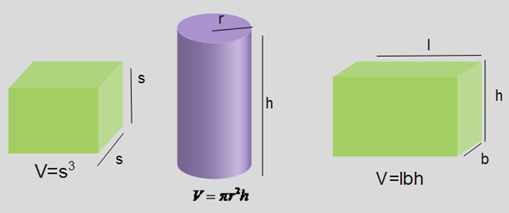
State and define the S.I unit of volume.
Answer
468.6k+ views
Hint: ln this question, we will study the basic definition of volume. This will directly give us the required result. Also, we will study the basics of other quantities like force, electric field and time with their S.I units, for our better understanding.
Complete solution:
As we know, volume is defined as the physical quantity of a three- dimensional space enclosed by a closed surface. If we take example: the space or shape occupied by the substance like solid, liquid, gas, or plasma.
Also, volume is often numerically given by using the S.I derived unit, called the cubic meter. This derived S.I unit for volume is the cubic meter based on the three dimensional use of the base unit for length, i.e., meter. The more common physical unit for volume is the liter.
Volumes of some shapes are given in the diagram below:

So, the SI unit of volume is given as ${m^3}$.
Additional information:
As we know, the electrostatic force is also known as Coulomb force. Electrostatic force is attractive force or repulsive force between two electrically charged objects.
Here, the electrostatic force is given by
$F = \dfrac{{k{q_1}{q_2}}}{{{r^2}}}$
Here, we know that the S.I unit of force is Newton, which is represented by N.
Now, the electric field is defined as the electric force per unit charge:
$E \propto \dfrac{F}{q}$
Here, F is force exerted or experienced by the object and q is the charge on the object. So, we can say that when the electric field at a given point is known to us and force is also known, then we can get the charge or if the charge is known to us we can get the force experienced by the point charge. As we know, the direction of electric field E is taken to be the direction of force it would exert on the positive test charge.
Also we know, time is defined by its measurement. Time is what a clock reads. In classical and non- relativistic physics, it is a scalar quantity. We know that length, mass and charge is usually described as a fundamental quantity, similarly time is also a fundamental quantity. The S.I unit of time is second.
Note:
We should remember that volume is a three- dimensional quantity, whereas area is the two dimensional quantity and length is one dimensional quantity. Also, there are many other units of volume as well. Volume is a measure of the closed system, or space.
Complete solution:
As we know, volume is defined as the physical quantity of a three- dimensional space enclosed by a closed surface. If we take example: the space or shape occupied by the substance like solid, liquid, gas, or plasma.
Also, volume is often numerically given by using the S.I derived unit, called the cubic meter. This derived S.I unit for volume is the cubic meter based on the three dimensional use of the base unit for length, i.e., meter. The more common physical unit for volume is the liter.
Volumes of some shapes are given in the diagram below:

So, the SI unit of volume is given as ${m^3}$.
Additional information:
As we know, the electrostatic force is also known as Coulomb force. Electrostatic force is attractive force or repulsive force between two electrically charged objects.
Here, the electrostatic force is given by
$F = \dfrac{{k{q_1}{q_2}}}{{{r^2}}}$
Here, we know that the S.I unit of force is Newton, which is represented by N.
Now, the electric field is defined as the electric force per unit charge:
$E \propto \dfrac{F}{q}$
Here, F is force exerted or experienced by the object and q is the charge on the object. So, we can say that when the electric field at a given point is known to us and force is also known, then we can get the charge or if the charge is known to us we can get the force experienced by the point charge. As we know, the direction of electric field E is taken to be the direction of force it would exert on the positive test charge.
Also we know, time is defined by its measurement. Time is what a clock reads. In classical and non- relativistic physics, it is a scalar quantity. We know that length, mass and charge is usually described as a fundamental quantity, similarly time is also a fundamental quantity. The S.I unit of time is second.
Note:
We should remember that volume is a three- dimensional quantity, whereas area is the two dimensional quantity and length is one dimensional quantity. Also, there are many other units of volume as well. Volume is a measure of the closed system, or space.
Recently Updated Pages
Master Class 12 Social Science: Engaging Questions & Answers for Success

Class 12 Question and Answer - Your Ultimate Solutions Guide

Class 10 Question and Answer - Your Ultimate Solutions Guide

Master Class 10 Science: Engaging Questions & Answers for Success

Master Class 10 Maths: Engaging Questions & Answers for Success

Master Class 9 General Knowledge: Engaging Questions & Answers for Success

Trending doubts
Is Cellular respiration an Oxidation or Reduction class 11 chemistry CBSE

In electron dot structure the valence shell electrons class 11 chemistry CBSE

What is the Pitti Island famous for ABird Sanctuary class 11 social science CBSE

State the laws of reflection of light

One Metric ton is equal to kg A 10000 B 1000 C 100 class 11 physics CBSE

Difference Between Prokaryotic Cells and Eukaryotic Cells




